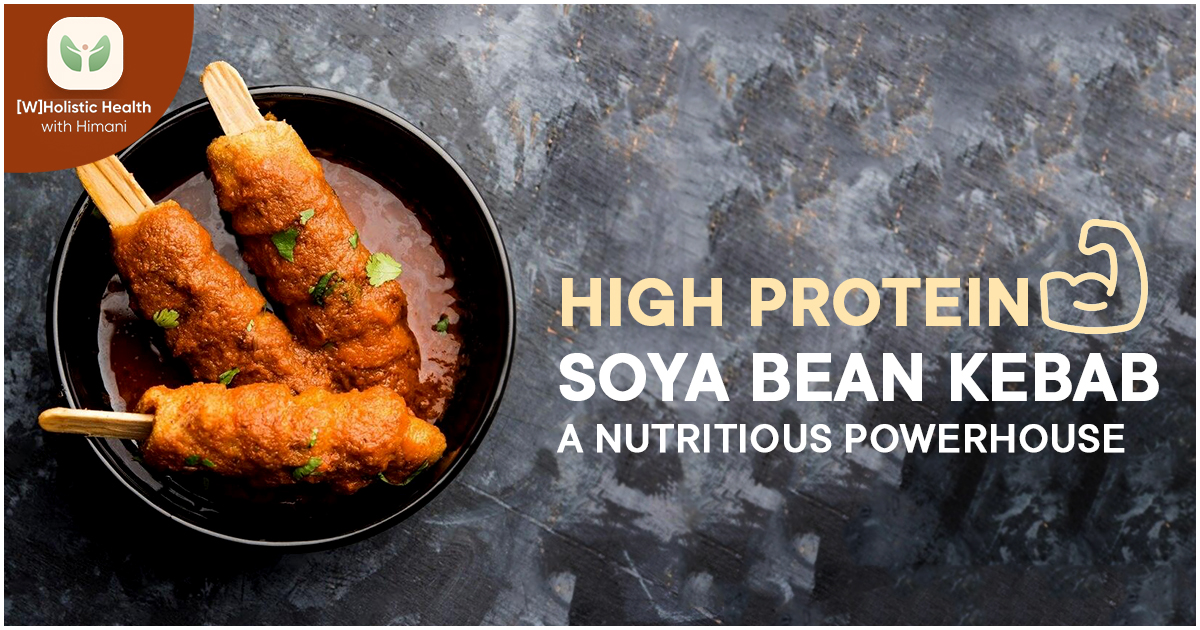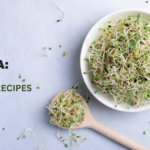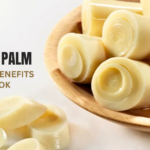Soya bean kebab is a protein-packed vegetarian alternative to traditional meat kebabs, offering a healthier and lighter option for those seeking plant-based nutrition. Made primarily from soya chunks, this dish is a testament to culinary innovation, combining the rich tradition of kebabs with the modern focus on plant-based eating. These delicious kebabs align with various dietary preferences, making them a versatile addition to any meal plan.
Table of Contents
ToggleHistory and Cultural Significance of Soya Bean Kebab
The concept of kebabs has a rich history dating back centuries, with its origins deeply rooted in Middle Eastern cuisine. Traditionally, kebabs were made by grilling small pieces of meat over an open flame. As the recipe traveled across regions and cultures, it underwent numerous adaptations to suit local tastes and dietary practices.
The vegetarian version, particularly the soya bean kebab, gained prominence in the Indian subcontinent as a response to the growing demand for meat alternatives. This innovation coincided with soya chunks’ increased availability and popularity in the mid-20th century.
Soya chunks, also known as textured vegetable protein (TVP) or soya nuggets, were first produced in the 1960s by Archer Daniels Midland Company. They were created as a byproduct of extracting soybean oil and quickly gained popularity due to their high protein content and meat-like texture.
Adapting soya chunks into kebabs represents a fusion of traditional cooking methods with modern nutritional science. This dish exemplifies how culinary traditions can evolve to meet changing dietary needs and preferences while maintaining cultural relevance.
Ingredients and Their Roles in Soya Bean Kebab
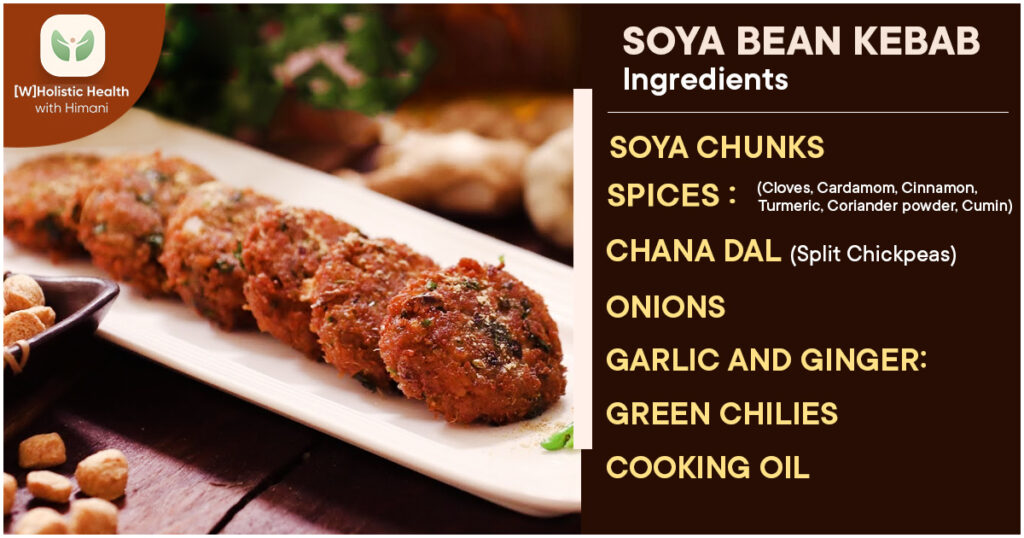
- Soya Chunks: The star ingredient, providing a meat-like texture and high protein content.
- Protein content: Approximately 52g per 100g (dry weight)
- Rich in essential amino acids
- Good source of iron and calcium
- Spices: A blend of aromatic Indian spices, typically including:
- Cloves: Anti-inflammatory and antioxidant properties
- Cardamom: Aids digestion and has antimicrobial effects
- Cinnamon: Helps regulate blood sugar and has antioxidant properties
- Turmeric: Contains curcumin, known for its anti-inflammatory and antioxidant effects
- Coriander powder: Rich in antioxidants and may help lower cholesterol
- Cumin: Aids digestion and has antimicrobial properties
- Chana Dal (Split Chickpeas):
- Adds texture and an earthy flavor
- High in fiber and protein
- Good source of folate and magnesium
- Onions:
- Provide flavor and natural sweetness
- Rich in antioxidants, particularly quercetin
- It contains prebiotic fibers for gut health
- Garlic and Ginger:
- Enhance flavor and provide numerous health benefits
- Garlic has antimicrobial properties and may help lower blood pressure
- Ginger has anti-inflammatory effects and can aid digestion
- Green Chilies:
- Add heat and flavor
- Rich in vitamin C and capsaicin, which may boost metabolism
- Cooking Oil:
- Preferably a heart-healthy option like olive oil or canola oil
- Necessary for cooking and achieving a crispy exterior
Nutritional Profile of Soya Bean Kebab
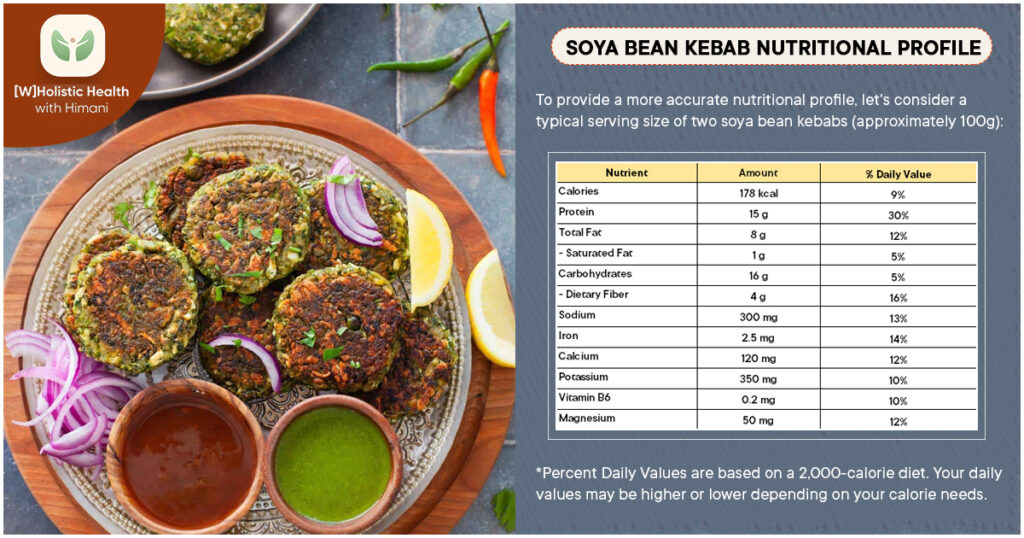
To provide a more accurate nutritional profile, let’s consider a typical serving size of two soya bean kebabs (approximately 100g):
| Nutrient | Amount per Serving | % Daily Value* |
|---|---|---|
| Calories | 178 kcal | 9% |
| Protein | 15g | 30% |
| Total Fat | 8g | 12% |
| – Saturated Fat | 1g | 5% |
| Carbohydrates | 16g | 5% |
| – Dietary Fiber | 4g | 16% |
| Sodium | 300mg | 13% |
| Iron | 2.5mg | 14% |
| Calcium | 120mg | 12% |
| Potassium | 350mg | 10% |
| Vitamin B6 | 0.2mg | 10% |
| Magnesium | 50mg | 12% |
*Percent Daily Values are based on a 2,000-calorie diet. Your daily values may be higher or lower depending on your calorie needs.
Health Benefits of Soya Bean Kebab
- High-Quality Protein Source: Soya chunks are a complete protein containing all nine essential amino acids the human body cannot produce independently. This makes soya bean kebabs an excellent option for vegetarians and vegans to meet their protein needs. A study published in the Journal of Agricultural and Food Chemistry (2018) found that soy protein has a Protein Digestibility Corrected Amino Acid Score (PDCAAS) of 1.0, equivalent to animal proteins like eggs and milk.
- Heart Health: Soya chunks are low in saturated fat and cholesterol-free, making them heart-friendly. The FDA has approved a health claim stating that 25 grams of soy protein per day may reduce the risk of heart disease when part of a diet low in saturated fat and cholesterol. A meta-analysis published in the Journal of the American Heart Association (2019) found that soy protein intake significantly reduced LDL cholesterol levels.
- Weight Management: Soya bean kebabs’ high protein and fiber content can promote satiety, potentially aiding in weight management. A study in the International Journal of Medical Sciences (2018) showed that high-protein diets, including those rich in soy protein, can help reduce body weight and fat mass while preserving lean body mass.
- Bone Health: Soy isoflavones, naturally occurring compounds in soya, may help maintain bone density, especially in postmenopausal women. A European Journal of Clinical Nutrition (2020) meta-analysis suggested that soy isoflavone supplementation could significantly increase bone mineral density in menopausal women.
- Antioxidant Properties: The spices used in soya bean kebabs, such as turmeric and cinnamon, are rich in antioxidants. These compounds help protect cells from damage caused by free radicals. A review in the International Journal of Molecular Sciences (2017) highlighted the potential of dietary antioxidants in preventing various chronic diseases.
- Digestive Health: The fiber content from soya chunks and chana dal can promote digestive health by supporting beneficial gut bacteria. A study in the Journal of Nutritional Science (2019) found that soy fiber could positively modulate the gut microbiome, potentially leading to improved digestive health.
- Menopausal Symptom Relief: Soy isoflavones have been studied for their potential to alleviate menopausal symptoms. A systematic review in Nutrients (2017) suggested that soy isoflavones might help reduce the frequency and severity of hot flashes in menopausal women.
Who Should Eat Soya Bean Kebab?
- Athletes and Bodybuilders: The high protein content (15g per serving) makes soya bean kebabs an excellent choice for muscle recovery and growth. A study in the Journal of the International Society of Sports Nutrition (2018) found that plant-based proteins, including soy, can be as effective as animal proteins in supporting muscle protein synthesis when consumed in adequate amounts.
- Vegetarians and Vegans: Soya bean kebabs are a complete protein source that can help those following plant-based diets meet their protein requirements. The American Dietetic Association states that well-planned vegetarian diets, including vegan ones, are healthful and nutritionally adequate for all life cycle stages.
- Individuals Managing Weight: The combination of protein and fiber in these kebabs can promote satiety, potentially aiding in weight management. A study in Obesity Science & Practice (2019) found that high-protein, plant-based meals could increase feelings of fullness and reduce overall calorie intake.
- Those with Cardiovascular Concerns: The low saturated fat content and presence of heart-healthy compounds make this dish suitable for those looking to improve their cardiovascular health. The American Heart Association recognizes soy products as a healthy alternative to meat sources.
- Individuals with Lactose Intolerance or Milk Allergies: Soya provides a calcium-rich alternative to dairy products, making it suitable for those who cannot consume milk or milk products.
Who Should Avoid Soya Bean Kebab?
- People with Soy Allergies: Those with known soy allergies should avoid soya bean kebab dish. The FDA recognizes soy as one of the eight most common food allergens.
- Individuals with Thyroid Issues: While moderate soy consumption is generally considered safe, those with thyroid conditions should consult their healthcare provider. A review in Environmental Health Perspectives (2017) suggested that soy isoflavones might interfere with the absorption of synthetic thyroid hormone medications.
- People on Low-Protein Diets: Individuals with certain kidney conditions may need to limit protein intake and consult a healthcare provider before including high-protein foods like soya bean kebabs.
- Those with Gout or High Uric Acid Levels: Soya is moderately high in purines, which can exacerbate gout symptoms in some individuals. A study in Clinical Rheumatology (2018) found that moderate purine intake from plant sources did not significantly increase the risk of gout attacks. However, caution is still advised for those with severe gout.
What is the Shelf Life and Storage of Soya Bean Kebab?
Proper storage is crucial for maintaining the quality and safety of soya bean kebabs:
- Refrigerator Storage:
- Cooked kebabs can be stored in an airtight container for 3-4 days.
- Ensure the kebabs are cooled to room temperature before refrigerating to prevent condensation.
- Freezer Storage:
- Uncooked or cooked kebabs can be frozen for up to 2 months.
- Place wax paper between layers of kebabs to prevent sticking.
- Use freezer-safe containers or bags to prevent freezer burn.
- Before Cooking:
- The prepared kebab mixture can be refrigerated for up to 24 hours before shaping and cooking.
- If making in advance, shape the kebabs and store them in the freezer, separated by wax paper.
- After Cooking:
- Allow kebabs to cool completely before storing to prevent moisture buildup.
- Reheat in a pan or oven until crispy and heated through.
A study in the Journal of Food Science and Technology (2019) found that vacuum-sealed, cooked soy products maintained better quality during frozen storage than in regular plastic containers.
Perfecting the Recipe Of Soya Bean Kebabs
To achieve the ideal texture and flavor in your soya bean kebabs:
- Soya Chunk Preparation:
- Boil soya chunks in salted water for 4-5 minutes, then drain and squeeze out excess water.
- This process helps remove any raw flavor and ensures proper hydration.
- Spice Roasting:
- Dry roast whole spices before grinding to enhance their flavors.
- A study in the International Journal of Food Properties (2017) found that dry roasting significantly increased the antioxidant activity of several spices.
- Texture Balance:
- Grind the mixture to a fine paste for cohesive kebabs, but leave some texture for a satisfying bite.
- Add finely chopped vegetables like bell peppers or carrots for added nutrition and texture.
- Binding:
- If the mixture is too wet, add breadcrumbs or besan (chickpea flour) to improve binding.
- For a gluten-free option, use rice flour or cornstarch as a binder.
- Cooking Method:
- For a healthier version, bake the kebabs at 200°C (400°F) for 20-25 minutes, turning halfway through.
- If pan-frying, use a non-stick pan and minimal oil to achieve a golden-brown crust.
What are Some Recipe Variations in Soya Bean Kebabs?
- Indian Style:
- For an authentic Indian flavor, incorporate garam masala, amchur (dried mango powder), and kasuri methi (dried fenugreek leaves).
- Serve with mint chutney and sliced onions.
- Middle Eastern Inspired:
- Use spices like za’atar, sumac, and baharat.
- Serve with tahini sauce and tabbouleh.
- Mediterranean Twist:
- Add finely chopped olives, sun-dried tomatoes, and oregano to the mixture.
- Serve with tzatziki sauce and a Greek salad.
- Asian Fusion:
- Add soy sauce, sesame oil, and finely chopped water chestnuts for texture.
- Serve with a sweet chili dipping sauce.
- Gluten-Free Version:
- Replace any wheat-based ingredients with gluten-free alternatives like rice flour or cornstarch.
- Ensure all spices and seasonings used are certified gluten-free.
Pairing Suggestions For Soya Bean Kebab Dish
- Chutneys and Sauces:
- Mint Chutney: Refreshing and cooling
- Tamarind Sauce: Sweet and tangy contrast
- Yogurt-based Raita: Balances spiciness
- Salads:
- Kachumber: Indian salad with cucumber, tomatoes, and onions
- Tabbouleh: Middle Eastern parsley and bulgur salad
- Greek Salad: Refreshing mix of cucumbers, tomatoes, olives, and feta
- Beverages:
- Lassi: Traditional Indian yogurt drink
- Iced Green Tea: Antioxidant-rich and refreshing
- Lemon Water with Mint: Aids digestion and complements the flavors
- Side Dishes:
- Quinoa Pilaf: For added protein and fiber
- Roasted Vegetables: Seasonal mix for added nutrients
- Whole Grain Flatbreads: Such as whole wheat naan or pita
How To Enrich Nutritional Value In Soya Bean Kebabs
To boost the nutritional profile of your soya bean kebabs:
- Add Leafy Greens: Incorporate finely chopped spinach or kale for added iron, calcium, and vitamins A and K.
- Chia or Flax Seeds: Add ground chia or flax seeds for omega-3 fatty acids and additional fiber.
- Nutritional Yeast: Sprinkle nutritional yeast into the mixture for a cheesy flavor and B-vitamin boost.
- Turmeric and Black Pepper: Increase the amount of turmeric and add black pepper to enhance curcumin absorption.
- Nuts and Seeds: Add finely chopped nuts or seeds for healthy fats and extra crunch.
Author Words on Soya Bean Kebabs
Soya bean kebabs represent a delicious fusion of traditional cooking methods and modern nutritional science. They offer a protein-rich, versatile alternative to meat-based dishes, suitable for various dietary preferences and restrictions. By understanding the nutritional profile, health benefits, and proper preparation techniques, you can create a dish that satisfies the palate and contributes significantly to a balanced, health-conscious diet.
As with any dietary change, it’s always advisable to consult with a healthcare professional or registered dietitian, especially for individuals with specific health concerns or dietary restrictions. This dish’s versatility allows for numerous variations and adaptations, making it a valuable addition to any culinary repertoire.
Remember, the key to a healthy diet lies in variety and moderation. Soya bean kebabs can be an excellent component of a balanced meal plan, offering both nutrition and gastronomic pleasure.

I’m Himani, a Singapore-based health coach certified by IIN. I help clients create personalized nutrition and lifestyle plans that lead to lasting health goals. By focusing on individual needs, I provide actionable steps to support your journey to optimal well-being



